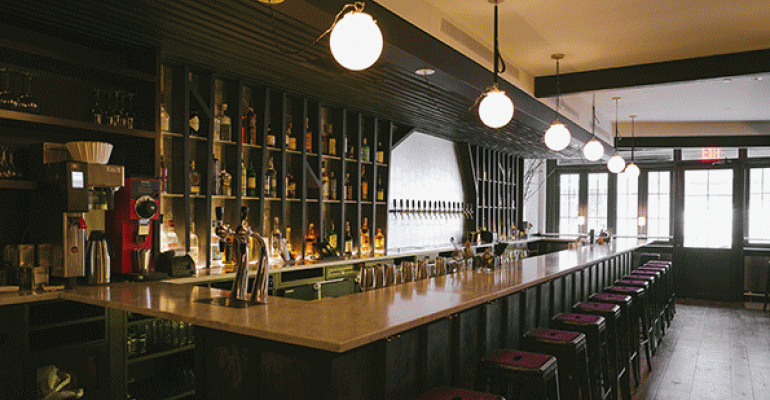
One of my favorite bars in New York City is called Angel’s Share. It’s a small speakeasy hidden behind a wall of a Japanese restaurant in the East Village. Operating for more than 20 years, it still elicits a “wow” from every new guest who enters. But I don’t love it for the normal reasons. It’s not the drinks (although they’re creative and beautifully made), it’s not the hospitality (which is superb), nor is it the space (you can watch snow fall from the picture window). For me, it’s all about the show. The bartenders move so effortlessly that I’m always transfixed. It’s a modern dance, a study in efficiency, with each bartender knowing so precisely where every tincture, syrup, garnish, tool or glass is kept that they could work the whole shift blindfolded. And while the staff is of the highest caliber, they’re only as good as their bar setup allows them to be.
All too often, the physical setup of a bar is an afterthought when designing a restaurant. By taking time to think through your bar team’s workflow, and to consult experts that have spent years navigating the oft-tiny real estate behind the bar, one can radically enhance profit, retain great talent, and ensure your labor costs are being smartly managed.
“The difference between a silver and a gold medal in Olympic sports is measured in fractions of seconds, and I want gold in my till,” said Sother Teague, beverage director at Amor y Amargo, a 240 square-foot bar in New York City. “Ergonomics are of great importance to me. If I can save a movement here, and a step there, I'm shaving seconds off of every transaction.”
Most of his team works 10-hour shifts, so it’s “important for the longevity of the staff to cut down on strenuous or unnecessary movements wherever possible,” he said. He advises any operator to take the time to bring in a consultant to assist with bar layout.

“A well-designed space means less time bartenders need to spend making drinks, and more time they can talk to guests, make connections, and get to the next rounds of drinks,” said Ben Sandler, owner of The Queens Kickshaw and Wassail, both in New York City. He advises that managers role-play through all the various steps of service, from entering orders into the POS system, to setting up a bar guest for food, all the way down to cleaning the bar at the end of service.
We’ve all watched bartenders flailing during service, and it’s usually due to poor layout of equipment and tools. Sandler says to also consider adding pre-batched, bottled, or kegged cocktails to help save time, or adding a chilled water tower that can allow bartenders to quickly pour non-sale items for guests, and not have to take extra seconds to add ice. He also suggests simple things, like adding a mirror behind the bar to allow staff to see what’s happening when they’re facing away from the guests, and to add under-counter lights, not only so employees can see what they’re doing, but also to ensure nothing gets overlooked during end-of-the-night cleaning.
Chris Elford, a long-time bartender, is currently opening two new bars in Seattle named No Anchor and Navy Strength. He’s fortunate to be starting from scratch to design his bars for maximum efficiency, plotting out every detail before construction.
“Labor is the biggest cost concern in a bar, and the more I can equip my staff to move hands, and not feet, the more effectively I can manage those costs,” he said. By having a better designed bar, he will need fewer bodies to serve guests, he said.
“Start with a very simple menu and squeeze as many tools and stations within arms’ reach as you can. The key elements of the bar — the dump sink, trash, ice, speed rail, glassware, and garnish station — should all be right there,” he said

Elford also recommends taking a close look at every bottle placed in the well or speed rack. If each of those bottles is not used three to four times in a shift, then get them out of there.
And any experienced bartender will tell you that the most often used piece of equipment is the ice bin, so ensuring it is placed at a height and position that is comfortable for staff to scoop and fill will save them from having to awkwardly reach or bend over. Fatigue and back pain are real foes for your bar staff, so having things like step ladders that are easily accessible, as well as glass storage in an easy-to-access spot, will go a long way in keeping your staff happy.
A well-constructed bar space that takes into account the anticipated workflow of your staff at every step is always a work in progress. But by taking the time to analyze that both at the time of construction, if possible, and definitely once your operation is up and running, will always reap benefits, both for your bottom line, and for your staff who will be spending hour after hour dancing through the space. Set them up for efficiency and comfort, and then watch them shine.





